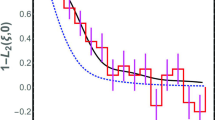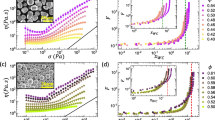Abstract
Generalization of the Rouse model without any use of the postulates concerning the Gaussian distribution of the vector connecting the ends of segments is advanced. In the initial (in general, nonlinear) Langevin equations, self-averaging over continuous fragments of a macromolecule naturally defines a linear term for the tagged chain, and this term differs from the entropy term of the classical Rouse model only by the numerical coefficient. According to the inertia-free approximation, the initial decay rates of correlation functions for the normal modes are described by the Rouse model independently of the character of fluctuations of the vector connecting the ends of the Kuhn segment. This statement is valid for any moment if the initial Langevin equations are treated in terms of the approximation of dynamic self-consistency. Simulation of the Fraenkel chains by the method of Brownian dynamics shows that decay of autocorrelation functions of shortwave normal modes is fairly described by the linearized equations for a given model of a chain and that the Rouse equation can be used for the long-wave modes. The results of this study make it possible to explain a marked difference between the lengths of the Kuhn and Rouse segments that is estimated from static and dynamic experiments.
Similar content being viewed by others
References
V. A. Kargin and G. L. Slonimskii, Zh. Fiz. Khim. 23, 563 (1949).
Yu. Ya. Gotlib, Thesis (Leningr. Gos. Univ., Leningrad, 1952).
Yu. A. Krutkov, Dokl. Akad. Nauk SSSR 1, 393 (1934).
Yu. A. Krutkov, Dokl. Akad. Nauk SSSR 1, 479 (1934).
Yu. A. Krutkov, Dokl. Akad. Nauk SSSR 3, 87 (1934).
Yu. A. Krutkov, Dokl. Akad. Nauk SSSR 3, 215 (1934).
Yu. A. Krutkov, Dokl. Akad. Nauk SSSR 1, 599 (1935).
Yu. A. Krutkov, Dokl. Akad. Nauk SSSR 5, 289 (1935).
P. E. Rouse, J. Chem. Phys. 21, 1273 (1953).
M. Doi and S. F. Edwards, The Theory of Polymer Dynamics (Clarendon, Oxford, 1986; Mir, Moscow, 1998).
P. G. De Gennes, Scaling Concepts in Polymer Physics (Cornell Univ. Press, Ithaca, 1970; Mir, Moscow, 1982).
A. Yu. Grosberg and A. R. Khokhlov, Statistical Physics of Macromolecules (Nauka, Moscow, 1969; American Institute of Physics, Ithaca, 1994).
Yu. Ya. Gotlib, A. A. Darinskii, and Yu. E. Svetlov, Physical Kinetics of Macromolecules (Khimiya, Leningrad, 1986) [in Russian].
J. D. Ferry, Viscoelastic Properties of Polymers (Wiley, New York, 1980).
R. Kimmich and N. Fatkullin, Adv. Polym. Sci. 170, 1 (2004).
W. W. Graessley, Adv. Polym. Sci. 47, 1 (1982).
N. K. Balabaev, Yu. Ya. Gotlib, A. A. Darinskii, and I. M. Neelov, Vysokomol. Soedin., Ser. A 20, 2194 (1978).
J. Skolnick and A. Kolinski, Adv. Chem. Phys. 78, 223 (1990).
K. Kremer and G. S. Grest, J. Chem. Phys. 92, 5057 (1990).
K. Binder and W. Paul, J. Polym. Sci., Part B: Polym. Phys. 35, 1 (1997).
J. S. Shaffer, J. Chem. Phys. 103, 761 (1995).
K. S. Schweizer, J. Chem. Phys. 91, 5802 (1989).
K. S. Schweizer, M. Fuchs, G. Szamel, et al., Macromol. Theory Simul. 6, 1037 (1997).
V. N. Pokrovskii, Adv. Polym. Sci. 154, 145 (2001).
N. F. Fatkullin, R. Kimmich, and M. Kroutieva, Zh. Eksp. Teor. Fiz. 118, 170 (2000).
M. A. Krut’eva, N. F. Fatkullin, and R. Kimmikh, Polymer Science, Ser. A 47, 1022 (2005) [Vysokomol. Soedin., Ser. A 47, 1716 (2005)].
G. K. Fraenkel, J. Chem. Phys. 20, 642 (1952).
Y.-H. Lin and A. K. Das, J. Chem. Phys. 126, 074902–1 (2007).
Y. Ding and A. P. Sokolov, J. Polym. Sci., Part B: Polym. Phys. 42, 3505 (2004).
A. Brodin, J. Chem. Phys. 128, 104901 (2008).
L. Harnau, R. G. Winkler, and P. Reineker, J. Chem. Phys. 102, 7750 (1995).
H. Meyer, J. P. Wittmer, N. Kreer, et al., Eur. Phys. J., E 26, 25 (2008).
Author information
Authors and Affiliations
Corresponding author
Additional information
Original Russian Text © N.F. Fatkullin, T.M. Shakirov, N.A. Balakirev, 2010, published in Vysokomolekulyarnye Soedineniya, Ser. A, 2010, Vol. 52, No. 1, pp. 67–76.
This work was supported by the Russian Foundation for Basic Research, project no. 07-03-00222-a.
Rights and permissions
About this article
Cite this article
Fatkullin, N.F., Shakirov, T.M. & Balakirev, N.A. Why does the rouse model fairly describe the dynamic characteristics of polymer melts at molecular masses below critical mass?. Polym. Sci. Ser. A 52, 72–81 (2010). https://doi.org/10.1134/S0965545X10010104
Received:
Revised:
Published:
Issue Date:
DOI: https://doi.org/10.1134/S0965545X10010104




